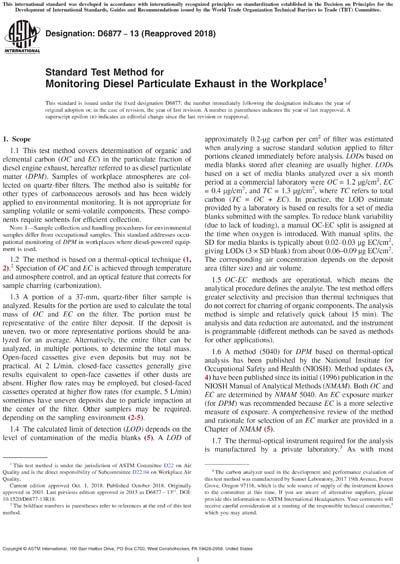Most recent
ASTM D6877-13(2018)
Standard Test Method for Monitoring Diesel Particulate Exhaust in the Workplace
1.1 This test method covers determination of organic and elemental carbon (OC and EC) in the particulate fraction of diesel engine exhaust, hereafter referred to as diesel particulate matter (DPM). Samples of workplace atmospheres are collected on quartz-fiber filters. The method also is suitable for other types of carbonaceous aerosols and has been widely applied to environmental monitoring. It is not appropriate for sampling volatile or semi-volatile components. These components require sorbents for efficient collection.
Note 1: Sample collection and handling procedures for environmental samples differ from occupational samples. This standard addresses occupational monitoring of DPM in workplaces where diesel-powered equipment is used.
1.2 The method is based on a thermal-optical technique (1, 2).2 Speciation of OC and EC is achieved through temperature and atmosphere control, and an optical feature that corrects for sample charring (carbonization).
1.3 A portion of a 37-mm, quartz-fiber filter sample is analyzed. Results for the portion are used to calculate the total mass of OC and EC on the filter. The portion must be representative of the entire filter deposit. If the deposit is uneven, two or more representative portions should be analyzed for an average. Alternatively, the entire filter can be analyzed, in multiple portions, to determine the total mass. Open-faced cassettes give even deposits but may not be practical. At 2 L/min, closed-face cassettes generally give results equivalent to open-face cassettes if other dusts are absent. Higher flow rates may be employed, but closed-faced cassettes operated at higher flow rates (for example, 5 L/min) sometimes have uneven deposits due to particle impaction at the center of the filter. Other samplers may be required, depending on the sampling environment (2-5).
1.4 The calculated limit of detection (LOD) depends on the level of contamination of the media blanks (5). A LOD of approximately 0.2-µg carbon per cm2 of filter was estimated when analyzing a sucrose standard solution applied to filter portions cleaned immediately before analysis. LODs based on media blanks stored after cleaning are usually higher. LODs based on a set of media blanks analyzed over a six month period at a commercial laboratory were OC = 1.2 µg/cm2, EC = 0.4 µg/cm2, and TC = 1.3 µg/cm2, where TC refers to total carbon (TC = OC + EC). In practice, the LOD estimate provided by a laboratory is based on results for a set of media blanks submitted with the samples. To reduce blank variability (due to lack of loading), a manual OC-EC split is assigned at the time when oxygen is introduced. With manual splits, the SD for media blanks is typically about 0.02–0.03 µg EC/cm2, giving LODs (3 × SD blank) from about 0.06–0.09 µg EC/cm2. The corresponding air concentration depends on the deposit area (filter size) and air volume.
1.5 OC-EC methods are operational, which means the analytical procedure defines the analyte. The test method offers greater selectivity and precision than thermal techniques that do not correct for charring of organic components. The analysis method is simple and relatively quick (about 15 min). The analysis and data reduction are automated, and the instrument is programmable (different methods can be saved as methods for other applications).
1.6 A method (5040) for DPM based on thermal-optical analysis has been published by the National Institute for Occupational Safety and Health (NIOSH). Method updates (3, 4) have been published since its initial (1996) publication in the NIOSH Manual of Analytical Methods (NMAM). Both OC and EC are determined by NMAM 5040. An EC exposure marker (for DPM) was recommended because EC is a more selective measure of exposure. A comprehensive review of the method and rationale for selection of an EC marker are provided in a Chapter of NMAM (5).
1.7 The thermal-optical instrument required for the analysis is manufactured by a private laboratory.3 As with most instrumentation, design improvements continue to be made. Different laboratories may be using different instrument models.
1.8 The values stated in SI units are to be regarded as standard. No other units of measurement are included in this standard.
1.9 This standard does not purport to address all of the safety concerns, if any, associated with its use. It is the responsibility of the user of this standard to establish appropriate safety, health, and environmental practices and determine the applicability of regulatory limitations prior to use. Specific precautionary statements are given in 7.1.5, 8.3, and 12.12.2.
1.10 This international standard was developed in accordance with internationally recognized principles on standardization established in the Decision on Principles for the Development of International Standards, Guides and Recommendations issued by the World Trade Organization Technical Barriers to Trade (TBT) Committee.
Content Provider
ASTM International [astm]






